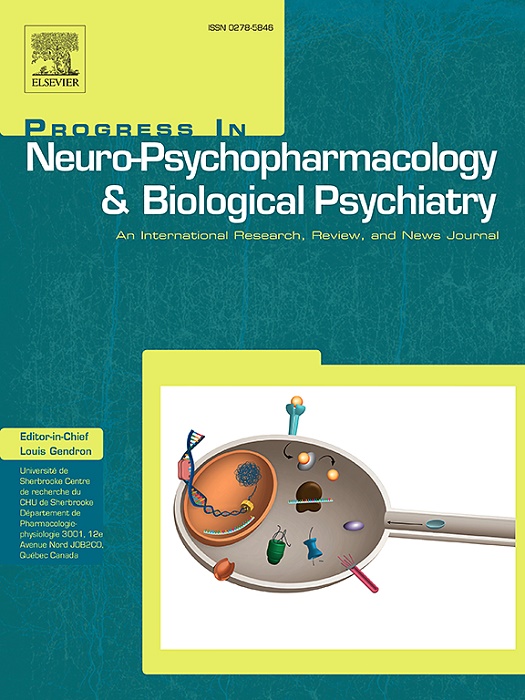Neurodevelopmental deviations in schizophrenia: Evidences from multimodal connectome-based brain ages
IF 3.9
2区 医学
Q1 CLINICAL NEUROLOGY
Progress in Neuro-Psychopharmacology & Biological Psychiatry
Pub Date : 2025-09-11
DOI:10.1016/j.pnpbp.2025.111498
引用次数: 0
Abstract
Background
Pathologic schizophrenia processes originate early in brain development, leading to detectable brain alterations via structural and functional magnetic resonance imaging (MRI). Recent MRI studies have sought to characterize disease effects from a brain age perspective, but developmental deviations from the typical brain age trajectory in youths with schizophrenia remain unestablished. This study investigated brain development deviations in early-onset schizophrenia (EOS) patients by applying machine learning algorithms to structural and functional MRI data.
Methods
Multimodal MRI data, including T1-weighted MRI (T1w-MRI), diffusion MRI, and resting-state functional MRI (rs-fMRI) data, were collected from 80 antipsychotic-naive first-episode EOS patients and 91 typically developing (TD) controls. The morphometric similarity connectome (MSC), structural connectome (SC), and functional connectome (FC) were separately constructed by using these three modalities. According to these connectivity features, eight brain age estimation models were first trained with the TD group, the best of which was then used to predict brain ages in patients. Individual brain age gaps were assessed as brain ages minus chronological ages.
Results
Both the SC and MSC features performed well in brain age estimation, whereas the FC features did not. Compared with the TD controls, the EOS patients showed increased absolute brain age gaps when using the SC or MSC features, with opposite trends between childhood and adolescence. These increased brain age gaps for EOS patients were positively correlated with the severity of their clinical symptoms.
Conclusion
These findings from a multimodal brain age perspective suggest that advanced brain age gaps exist early in youths with schizophrenia.
精神分裂症的神经发育偏差:来自多模态连接体脑年龄的证据。
背景:病理性精神分裂症过程起源于大脑发育早期,通过结构和功能磁共振成像(MRI)导致可检测的大脑改变。最近的MRI研究试图从脑年龄的角度来描述疾病的影响,但精神分裂症青年患者与典型脑年龄轨迹的发育偏差仍未确定。本研究通过将机器学习算法应用于结构和功能MRI数据,研究了早发性精神分裂症(EOS)患者的大脑发育偏差。方法:收集80例首发抗精神病EOS患者和91例典型发展(TD)对照者的多模态MRI数据,包括t1加权MRI (T1w-MRI)、弥散MRI和静息状态功能MRI (rs-fMRI)数据。形态学相似性连接组(MSC)、结构连接组(SC)和功能连接组(FC)分别使用这三种模式构建。根据这些连通性特征,首先与TD组一起训练8个脑年龄估计模型,然后将其中最好的模型用于预测患者的脑年龄。个体脑年龄差距被评估为脑年龄减去实足年龄。结果:SC和MSC特征在脑年龄估计中都有良好的表现,而FC特征则没有。与TD对照组相比,EOS患者在使用SC或MSC特征时显示出绝对脑年龄差距增加,而在儿童期和青春期之间则相反。EOS患者脑年龄差距的增加与其临床症状的严重程度呈正相关。结论:从多模态脑年龄的角度来看,这些发现表明,精神分裂症青少年早期存在较大的脑年龄差距。
本文章由计算机程序翻译,如有差异,请以英文原文为准。
求助全文
约1分钟内获得全文
求助全文
来源期刊
CiteScore
12.00
自引率
1.80%
发文量
153
审稿时长
56 days
期刊介绍:
Progress in Neuro-Psychopharmacology & Biological Psychiatry is an international and multidisciplinary journal which aims to ensure the rapid publication of authoritative reviews and research papers dealing with experimental and clinical aspects of neuro-psychopharmacology and biological psychiatry. Issues of the journal are regularly devoted wholly in or in part to a topical subject.
Progress in Neuro-Psychopharmacology & Biological Psychiatry does not publish work on the actions of biological extracts unless the pharmacological active molecular substrate and/or specific receptor binding properties of the extract compounds are elucidated.

 求助内容:
求助内容: 应助结果提醒方式:
应助结果提醒方式:


